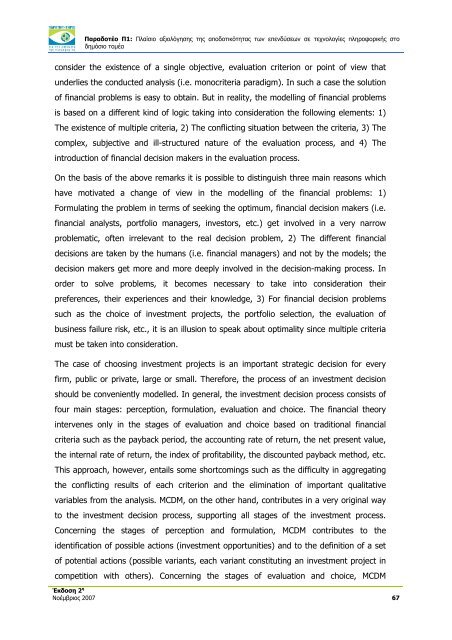ΠλαίÏιο αξιολÏγηÏÎ·Ï ÏÎ·Ï Î±ÏοδοÏικÏÏηÏÎ±Ï ÏÏν εÏενδÏÏεÏν Ïε ...
ΠλαίÏιο αξιολÏγηÏÎ·Ï ÏÎ·Ï Î±ÏοδοÏικÏÏηÏÎ±Ï ÏÏν εÏενδÏÏεÏν Ïε ...
ΠλαίÏιο αξιολÏγηÏÎ·Ï ÏÎ·Ï Î±ÏοδοÏικÏÏηÏÎ±Ï ÏÏν εÏενδÏÏεÏν Ïε ...
You also want an ePaper? Increase the reach of your titles
YUMPU automatically turns print PDFs into web optimized ePapers that Google loves.
Παραδοτέο Π1: Πλαίσιο αξιολόγησης της αποδοτικότητας των επενδύσεων σε τεχνολογίες πληροφορικής στο<br />
δημόσιο τομέα<br />
consider the existence of a single objective, evaluation criterion or point of view that<br />
underlies the conducted analysis (i.e. monocriteria paradigm). In such a case the solution<br />
of financial problems is easy to obtain. But in reality, the modelling of financial problems<br />
is based on a different kind of logic taking into consideration the following elements: 1)<br />
The existence of multiple criteria, 2) The conflicting situation between the criteria, 3) The<br />
complex, subjective and ill-structured nature of the evaluation process, and 4) The<br />
introduction of financial decision makers in the evaluation process.<br />
On the basis of the above remarks it is possible to distinguish three main reasons which<br />
have motivated a change of view in the modelling of the financial problems: 1)<br />
Formulating the problem in terms of seeking the optimum, financial decision makers (i.e.<br />
financial analysts, portfolio managers, investors, etc.) get involved in a very narrow<br />
problematic, often irrelevant to the real decision problem, 2) The different financial<br />
decisions are taken by the humans (i.e. financial managers) and not by the models; the<br />
decision makers get more and more deeply involved in the decision-making process. In<br />
order to solve problems, it becomes necessary to take into consideration their<br />
preferences, their experiences and their knowledge, 3) For financial decision problems<br />
such as the choice of investment projects, the portfolio selection, the evaluation of<br />
business failure risk, etc., it is an illusion to speak about optimality since multiple criteria<br />
must be taken into consideration.<br />
The case of choosing investment projects is an important strategic decision for every<br />
firm, public or private, large or small. Therefore, the process of an investment decision<br />
should be conveniently modelled. In general, the investment decision process consists of<br />
four main stages: perception, formulation, evaluation and choice. The financial theory<br />
intervenes only in the stages of evaluation and choice based on traditional financial<br />
criteria such as the payback period, the accounting rate of return, the net present value,<br />
the internal rate of return, the index of profitability, the discounted payback method, etc.<br />
This approach, however, entails some shortcomings such as the difficulty in aggregating<br />
the conflicting results of each criterion and the elimination of important qualitative<br />
variables from the analysis. MCDM, on the other hand, contributes in a very original way<br />
to the investment decision process, supporting all stages of the investment process.<br />
Concerning the stages of perception and formulation, MCDM contributes to the<br />
identification of possible actions (investment opportunities) and to the definition of a set<br />
of potential actions (possible variants, each variant constituting an investment project in<br />
competition with others). Concerning the stages of evaluation and choice, MCDM<br />
Έκδοση 2 η<br />
Νοέμβριος 2007 67
















